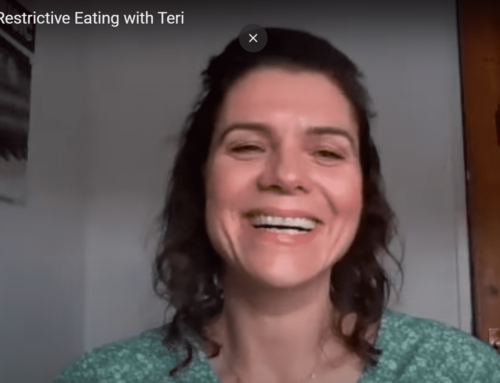Making calorie tracking less intimidating
The aim of this article is to give you some calorie tracking tips to help you feel less overwhelmed by this powerful educational tool.
Many people find the idea of counting calories intimidating, but it doesn’t have to be that way. I’ve already written about the benefits of simplifying calorie tracking when it comes to achieving your health and fitness goals.
Whilst you might think that focussing on numbers might spoil your relationship with food, for me it’s actually the opposite.
Understanding your food choices allows you to make informed decisions which can help you to include your favourite foods (in the right moderation) to still make progress:

*please eat ice cream responsibly (or at least in moderation)
Whilst lots of people think they need to eat like a bodybuilder or follow a restrictive meal plan to make progress, the reality is they need to plan their meals before they get hungry.
Calorie tracking basically allows you to build your own meal plan around foods you actually enjoy which in turn makes it way more sustainable.
In this article, you’ll find practical tips to make calorie tracking less intimidating, learn how it can be an educational and empowering experience, plus I’ll let you in on some common mistakes to avoid.
Simple calorie tracking tips
Here are a few tips and tricks that help all of my online nutrition coaching clients when they first get started with calorie tracking. Pick the ones that feel easiest and make the most sense for you.
1. Start small
Begin with tracking your breakfast for a week, once that’s dialled in then move on to lunch, dinner etc.
2. Simplify food choices
Choose simple, whole foods that are easy to track.
For example 200g of chicken breast, 180g of potato, 10g butter and a side of broccoli and spinach (untracked – see below).
Pro tip: use the staple foods option in MyNetDiary to help you reduce the choices.
3. Don’t track non-starchy vegetables
Probably my biggest calorie tracking tip is this ‘rule’ I use with all my nutrition clients. Basically I ask them not to track any vegetables unless it’s a potato.
Whilst non-starchy veg like broccoli, lettuce etc. do contain calories they are fairly negligible. I always joke that it burns more calories tracking a quarter of a red onion than it does eating it!
4. Reduce variety
Too many options create overwhelm. Reduce your decision making by having 2-3 simple breakfasts, lunches and snacks that you rotate throughout the week. You can obviously plan for more but saving time and energy through simplicity can be a game changer if you’re busy.
5. Plan
Forward planning prevents you from being overwhelmed by what to eat. Enter your meals in your calorie tracking app at the start of the day or the evening before. You can always change them but it gives you clarity of what to prepare, buy or eat.
6. Learn to read a food label
Food labelling gives a lot of valuable information and is a great way to check that the calories shown in an app are accurate. You can find out more in the British Nutrition Foundation’s guide to calorie labelling.
Another great way to find out the calories in your favourite meals is to use the BBC Good Food website as their recipes usually have comprehensive nutrition information. Here’s how to use the BBC good food website to find healthy recipes:
7. Save your regular meals
Save your regular meals in your calorie tracking app so you only need to track them once. Here’s how to save a meal in the MyNetDiary app.
8. Move the biggest rocks
Calories are the most important bit to get right for any goal. Most people should focus on calories then protein and/or fibre in that order of importance.
The amount of carbohydrate and fat in your diet really isn’t important for most goals provided calories and protein are in check. If you have an athletic goal just make sure your diet has plenty of carbohydrates to fuel explosive activity and you’ll be most of the way there.
9. Add dinner and work backwards
If you find yourself ‘running out of calories’ by dinner time then it can help to populate that meal first. Likewise if there is something you really want to eat for the day, like a burger with your friends in the pub or a particular dessert, log that first then build the rest of your meals around it.
10. Split up portions
If something is higher in calories, remember you don’t have to eat whole portions of things. For example, if you only have enough calories remaining in your ‘budget’ for a half a sausage roll, eat half and save the rest. My wife and I like to share a cake at a coffee shop rather than eating the whole thing but that’s not for everyone…
11. Take an educated guess
If you can’t figure out how to track something just take a best guess. Just like any skill you learn and refine it over time. After all, a wild guess is better than no guess at all. If you can’t figure out how a meal is made, look up a similar recipe that has some calorie information (the BBC Good Food Website is a great resource) and use that.
12. Be flexible
It’s natural and completely normal to eat more on some days than others. Here are two tips to help you to embrace flexibility when tracking calories.
Focus on the weekly average
Going past your calorie goal is not a failure because the weekly average, not a single day or meal, is what matters most. If you go over your targets then adjust the following few days.
Here’s how to find your weekly averages in MyNetDiary:
Use a calorie range
Calorie tracking is inaccurate so use that to your advantage by setting a calorie range rather than a rigid target. For example, if your calorie goal is 1739 calories per day (a horribly accurate number) then aim for an average of 1600-1900 per day.
13. Track unusual day/items
If you know your regular diet is ‘on point’ you can simply track the calories in unusual meals or items.
Want to head out for a pizza but aren’t sure of the impact? Track it.
Fancy some ice cream? Read the label and see the impact.
14. Positive Mindset
Try to treat calorie tracking as a learning tool. You will get it wrong from time to time but that’s just part of the learning process.
If you go ‘big’ and overeat, track it anyway. By accepting that this is perfectly normal you’re then able to understand the impact rather than berating yourself.
When you do that, you’ll often find that those ‘naughty’ foods you have been excluding can fit into your day more often with the right planning and moderation because you now understand their calorie content.
Calorie tracking can be highly educational
Remember, learning a new skill is intimidating for everyone. You’ll get things wrong to begin with but practice really does make perfect.
You start to understand the nutritional content of your food
Calorie tracking apps and food labels help you to understand how your food is made up and ultimately how it contributes towards your overall goal.
Struggling to get enough protein? Apps like MyNetDiary will tell you the foods contributing the most in your regular diet so you can choose to include more of them.
Portion sizes
Calorie tracking can be a great way to educate yourself on portion sizes. Rather than just pouring stuff into a bowl or pan, weigh and track it for a bit.
For example, if you’re not sure if you’re eating too much rice then weigh it out and enter it into your tracking app. If you’re too far under your calorie target then you know the portion needs to be larger or you should eat something else as well.
Balancing your diet
Having better understood the nutritional content of your food and what portions are appropriate for your goal you’re now in a far better position to build a balanced plate of food more regularly.


Tracking calories in meals you haven’t made yourself
Tracking calories in home cooked meals
Here’s a quick overview of how simple it can be to track a home cooked meal. I’ve used the example of a roast dinner but you can apply the same principles to any meal.
Tracking calories when eating out
Eating out is always going to end up being a higher calorie option.
If you’re headed out for dinner, look at the menu ahead of time so you have a plan.
- Where the restaurant has calorie information on the menu (or online) use that information.
- Search for the equivalent meal at a chain restaurant (even if that’s not the one you’re eating in). For example ‘Weahtherspoons burger and chips’ or ‘Pizza Express Lasagne’.
- Track the meal as if you’d made it yourself but add in 30% extra calories than usual (or 1-2 tbsp of oil) to account for the chef making it extra tasty.
- Take an educated guess. As a rule of thumb, most restaurant meals are 750 – 1500 calories for a main, 700 for a starter, 700 – 1000 for a desert.
Calorie tracking is not just for fat loss
If you have a high activity level you may not be eating enough, either through fear of fat gain or a combination of low appetite and high activity levels. Calorie tracking really helped my client Teri to know how many calories she needed to support her exercise:
Avoid these common mistakes with calorie tracking
I’ve already said a best guess is better than nothing but if you’re not making the progress you’d like consider correcting these common errors with calorie tracking.
Adjusting for exercise:
It may be tempting to add ‘calories burnt’ to your daily total but the reality is that any calorie estimation already includes those calories burnt so adding them back is essentially ‘double counting’ and can often lead to overconsumption of calories. Here’s how to ensure you’re not counting exercise calories in MyNetDiary:
Measure and track before you eat
Rather than eating your meal and then trying to figure out the portions, plan your meals in your calorie tracking app first to get a rough idea of total calories then weigh/measure the component parts.
Remember:
- Weigh everything you can, measuring cups and spoons are not accurate
- Weigh in the raw or uncooked state and track the item that way. It’s more consistent that way
- Track any oils or butter used for cooking
- Track alcohol or drinks with calories
- Track any bites of food even if they’re off your kids plate or during cooking
You still need to eat like a grown up!
Whilst calorie tracking allows you to eat things like ice cream, cake and pizza whilst still maintaining calorie balance those should not be the only foods you eat.
Make sure at least 80% of your calories come from wholesome nutritious sources (which I talk about in my article ‘calorie control made easy’) to ensure you are properly nourished and your hunger is managed properly.
Conclusion: Keeping calorie tracking simple
By starting small, using the right tools with the right level of detail and focusing on building nourishing meals, you can make calorie tracking far more manageable so you get the full benefit of the education and flexibility it brings.
Remember, treat it as a learning process and focus on consistency over perfection. Start your calorie tracking journey by downloading a calorie tracking app today and take the first step towards crushing your nutrition goals!
If you’re still a little unsure, here’s the deal
- download the MyNetDiary app
- track your meal
- post a photo and a screenshot of your tracking to your social media (tagging @foodflexibility)
- I’ll give you my feedback to help you learn
Thanks for reading
Tim



